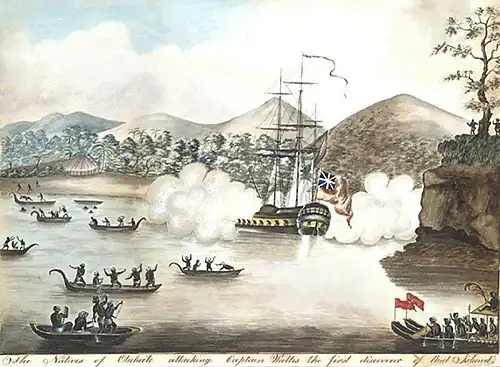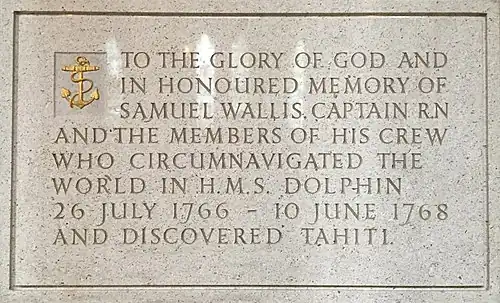Samuel Wallis
Samuel Wallis | |
|---|---|
 Portrait of Samuel Wallis by Henry Stubble, c. 1785 | |
| Born | 23 April 1728 Fentenwoon, Cornwall |
| Died | 21 January 1795 (aged 71) Devonshire Street, London |
| Allegiance | |
| Branch | |
| Years of service | c.1748–1795 |
| Rank | Captain |
| Commands | HMS Swan HMS Port Mahon HMS Prince of Orange HMS Dolphin HMS Torbay HMS Dublin HMS Queen |
| Known for | Pacific exploration |
| Battles / wars | |
| Spouse(s) | Betty Hearle |
| Other work | Extra Commissioner of the Navy |



Captain Samuel Wallis (23 April 1728 – 21 January 1795) was a Royal Navy officer and explorer who made the first recorded visit by a European navigator to Tahiti.
Biography
Wallis was born at Fenteroon Farm, near Camelford, Cornwall. He served under John Byron. In 1757, he was promoted to captain and was given the command of HMS Dolphin as commander of an expedition accompanied by Philip Carteret on HMS Swallow with an assignment to circumnavigate the globe.[1] As was reported in the press, he was also tasked with discovering the Southern Continent.[2] The two ships were parted by a storm shortly after sailing through the Strait of Magellan. In June 1767, the expedition made the first European landfall on Tahiti, which he named "King George the Third's Island" in honour of the King. Wallis himself was ill and remained in his cabin so lieutenant Tobias Furneaux was the first to set foot, hoisting a pennant and turning a turf, taking possession in the name of His Majesty. He described Tahiti as having a very good climate and the island being 'one of the most healthy as well as delightful spots in the world'.[3]
HMS Dolphin's purser, John Harrison,[a] had the skills necessary to calculate longitude by the Lunar Distance method. This was an early version of the technique, predating the first nautical almanacs which included tables that shortened the calculation process. Consequently, Harrison had lengthy calculations (taking about four hours) to turn each observation into a longitude position. Wallis freely admitted that he did not understand these calculations. Determining the longitude (together with the latitude) of Tahiti meant that the later voyage by James Cook had no difficulty in finding the island. The lunar distance longitude was added to by observation of a solar eclipse which occurred during Dolphin's stay, which provided an additional fix. The two longitudes obtained provided a level of precision greater than could be achieved by previous navigators.[4]
Dolphin stayed in Matavai Bay in Tahiti for over a month.[1] Wallis went on to name or rename five more islands in the Society Islands and six atolls in the Tuamotu Islands, as well as confirming the locations of Rongerik and Rongelap in the Marshall Islands. He renamed the Polynesian island of Uvea as Wallis after himself, before reaching Tinian in the Mariana Islands.[1] He continued to Batavia, where many of the crew died from dysentery, then via the Cape of Good Hope to England, arriving in May 1768.
Following his return in England, Wallis was able to pass on useful information to James Cook, who was due to depart shortly for the Pacific, and some of the crew from the Dolphin sailed with Cook. Although Cook carried an official report of Wallis's circumnavigation, it is not known whether the two met prior to Cook's departure in August 1768.[4]
In 1780, Wallis was appointed an Extra Commissioner of the Navy.
See also
Notes
- ^ Not to be confused with John Harrison, the developer of the first marine chronometer
References
- ^ a b c Quanchi, Historical Dictionary of the Discovery and Exploration of the Pacific Islands, p. 248
- ^ The Public Ledger and The Gazetteer, 5 July 1766.
- ^ John Hawkesworth, An Account of the Voyages Undertaken by the Order of His Present Majesty for Making Discoveries in the Southern Hemisphere, Chapter VIII, p. 313
- ^ a b Cock, Randolph (1 January 1999). "Precursors of Cook: The Voyages of the Dolphin, 1764–8". The Mariner's Mirror. 85 (1): 30–52. doi:10.1080/00253359.1999.10656726. ISSN 0025-3359. Retrieved 1 August 2025.
Bibliography
- Glyndwr Williams, 'Wallis, Samuel (1728–1795)', Oxford Dictionary of National Biography, Oxford University Press, 2004; online edn, May 2005 accessed 10 Dec 2007
- Quanchi, Max (2005). Historical Dictionary of the Discovery and Exploration of the Pacific Islands. The Scarecrow Press. ISBN 0810853957.
- Hawkesworth, John; Byron, John; ; Carteret, Philip; Cook, James; Banks, Joseph (1773), An account of the voyages undertaken by the order of His present Majesty for making discoveries in the Southern Hemisphere, and successively performed by Commodore Byron, Captain Wallis, Captain Carteret, and Captain Cook, in the Dolphin, the Swallow, and the Endeavour drawn up from the journals which were kept by the several commanders, and from the papers of Joseph Banks, esq, London Printed for W. Strahan and T. Cadell, Volume I, Volumes II–III